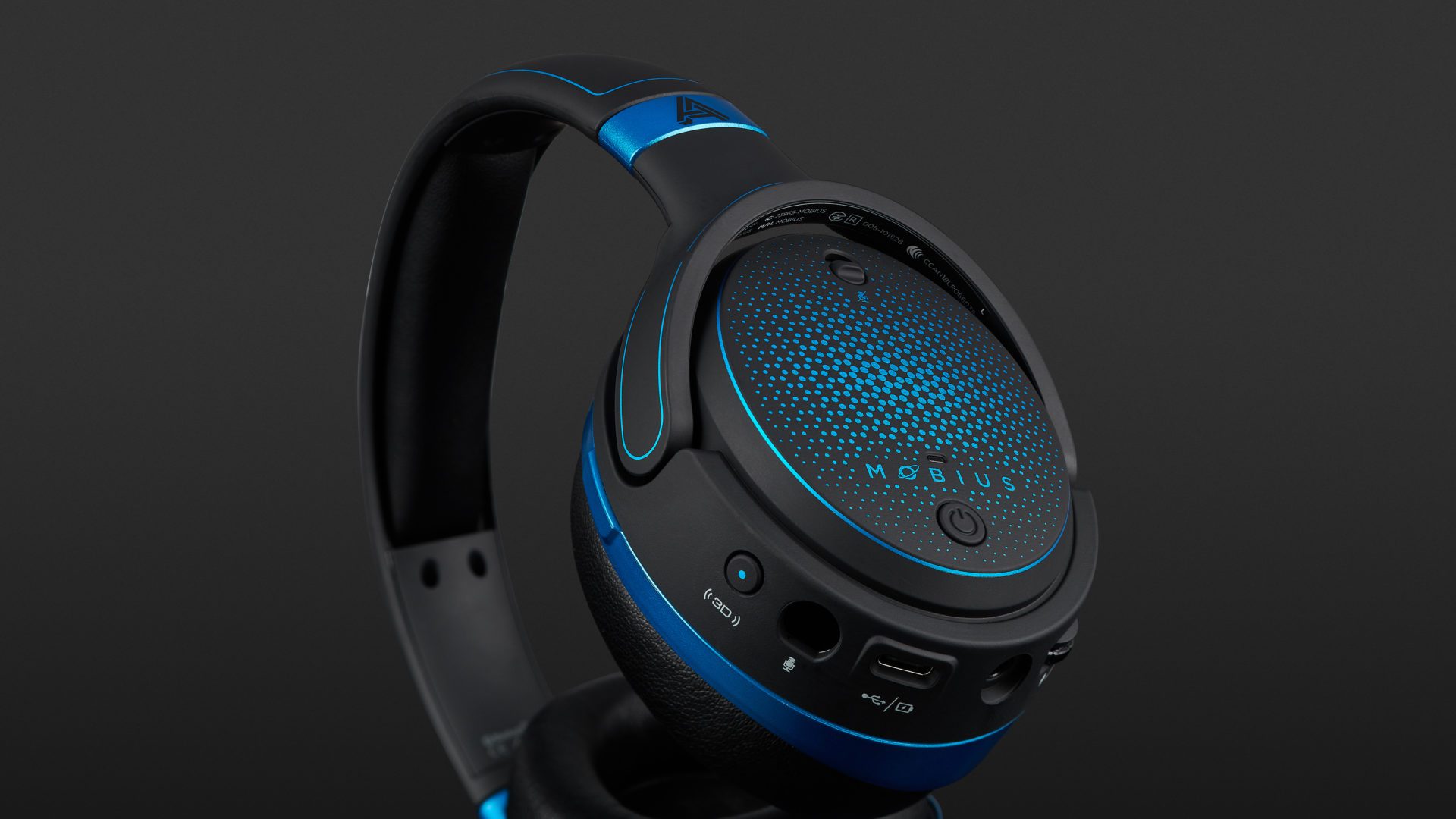With the Mobius, Audeze appeals to gamers with a technically appealing package. These headphones are more than likely going to cause something of a stir, especially when you consider the VR applications of them. For gaming and movie enjoyment via USB, the Mobius meets high demands on sound quality and is likely to keep up with the ASUS ROG Centurion. This particular device relies on five drivers per ear, while the Audeze product scores well with spatial, airy and detailed magnetostatic drivers. Even when the 3D functionality is turned off, these drivers deliver a first-class result. That’s why the Mobius is a must for those after an audiophile headphone that boasts versatile connection options and holds up well within its price range, even in competition with the likes of the wired EL-8 series. In summary, the Mobius delivers a formidable sound performance, but weakens in some details like the often fiddly operation. In addition to the regular version, the Mobius is also available as a Creators Edition, which includes 3D plug-ins from Waves, an Ambisonics B360 encoder, plus Waves Nx Virtual Room. This should definitely appeal to those in the market for content creation for virtual and augmented reality.
The US manufacturer Audeze is already well known for its audiophile magnetostatic headphones. The design has been incorporated into this Mobius model, promising the best possible sound quality. However, while the Mobius is full to bursting with innovative technology, it’s focused squarely at the gaming market. Gamers will benefit from high sound quality, impressive 3D sound performance and head tracking tech.

Appearance
First and foremost, the Mobius is a rugged closed-back, over-ear headphone with integrated electronics. The model, available in two attractive colours, makes an instant impression with a slick exterior. The design of the test device clearly makes a point to address the player, with market-centric features like the flexible (and detachable) microphone. Materials typically found in the hi-fi sector aren’t used here. Included with the headphones themselves are all the necessary connection cables you’ll need, while a carrying bag and stand are optional extras.
Handling
The Mobius can be operated in several different ways. In USB mode, the electronics play out in impressive scope when it comes to this headphone set as an audio device. Surround signals up to 7.1 can be fed into the headphones and transformed into an authentic room simulation, with the addition of head tracking technology to boot. The manufacturer has cooperated with Israeli tech company Waves, a market leader in the field of studio technology. The NX technology used simulates the impression of a more spatial loudspeaker reproduction via the headphones. However, the design is not limited to a two-channel stereo level. Additionally, it can also simulate surround sound while being able to utilise the Ambisonics B format for quality 3D sound reproduction.
SBC, AAC and high-resolution LDAC codecs can all be used via Bluetooth. Head tracking, loudspeaker simulation and the microphone also work here, although you are indeed limited to two-channel audio playback. The same applies when using the headphones via a conventional analogue connection.
Much of the functionality of these headphones is controlled via the buttons found on the left earpiece. Here you’ll find the on/off switch, which can also be used for device pairing, not to mention handling phone calls in Bluetooth mode and start/stop commands when playing music. A second switch found here can be used to activate or deactivate the impressively crisp and clean microphone, while a further control allows you to adjust its volume. Ideal for gaming needs. Another button allows you to configure centring or automatic tracking of head movements, although this can also be switched off for when you’re simply looking to enjoy music. A volume control option is also available. Both this and the microphone control have push functionality, allowing you to jump between titles and select from seven equaliser presets. You can choose to switch between 2 Channel, 7.1 and HiRes modes.
Experience
The wearing comfort of these headphones is great thanks to the faux leather padding of the orating ear cups, while the adjustable headband allows for a good fit. What’s more, passive noise insulation is decidedly solid. The Mobius can be worn for a long time without signs of discomfort like pinching, with enough pressure on the ears to keep the headphones in place and free from the risk of slipping from the head. The ear cushions are also interchangeable, allowing you to replace them with ease.
A charged battery is always required, with the headphones powered and charged via USB connection to a computer. The battery life is approximately 10 hours in total when the 3D function is activated while charging time is a respectable three hours, on average.
The general operation of the Mobius takes some getting used to, with the high number of control elements and individual functions making things a bit fiddly. In the future, I’d like to see more of a user-friendly approach to things in the form of a smartphone app that we’ve already seen with some of Audeze’s other products.
There are also some technical specifics to delve into. It bothers me that Mobius does not remember the status of the 3D simulation. If you want to use the headphones for simple music playback, you first need to switch from surround sound to dual-channel mode as the sound was not routed correctly to the headphones initially. I also had sound problems with both 3D simulations and multi-channel USB movie playback. This may have something to do with settings and codecs where the user manual doesn’t really offer an explanation. In the further stages of the product test, however, there were no further inconsistencies worth reporting.
Sound
First and foremost, the Mobius is a headphone that can really hit high and provides an excellent overall sound quality. It delivers significant volume and its noise-cancelling capabilities block out external distractions.
In the case of magnetostatic designs, magnetic material used within the membrane element. This material can then be moved directly within a magnetic field that has static magnets both in front and behind it. Such headphones are distinguished by differentiated dynamics and high levels of transparency, both of which apply to the Mobius!
The manufacturers relied on their years of experience here, resulting in a high level of sound quality when listening to music, for which I deactivated the 3D mode.
The Mobius has clean tones, with a deep and tight bass, open and airy trebles and a balanced, warm and harmonious midrange. In addition to this, it responds quickly to transients and delivers an incredibly precise and wide panorama. At this juncture, I’d like to point out the good dynamics and generally solid balanced tuning. In the bass range, the headphones don’t sound too thick, despite the astonishingly low bass reproduction. In the treble, they avoid harshness. As a result, listening pleasure is assured, meaning these headphones score highly for such a price point. These are recommended for all genres, from orchestral recordings to jazz, rock and club tracks alike. The EQ presets keep the music balanced, but tend to find their calling more when it comes to gaming.
3D sound reproduction
The focus here is, of course, the ability of the Mobius to simulate 3D sound, especially via USB. This is possible thanks to the multi-channel sound processing capabilities of the Mobius. In fact, with certain films and trailers, an impressive degree of spatial sound is achieved for a truly immersive experience. This makes the Mobius an ideal choice for enjoying blockbusters on the computer, even if switching between 3D and surround modes occasionally results in changes in volume.
Gaming Experience
When we turn to gaming – the target market of the Mobius – things become even more relevant. You can achieve a wonderful spatial sound, depending on the game, of course. Head-tracking also impresses, with six axles to ensure precise following of head movements, even when movements are rapid. In terms of virtual reality, this is an outstanding feature. Particularly when combined with VR glasses for games and simulations, it’s an almost unrivalled one.
The Mobius does well in gaming as expected. No matter if you’re playing a shooter, platformer or racing game, everything sounds excellent. As expected, head tracking on the screen is only useful to a limited extent. Although it may be helpful in one situation or another to acoustically determine the position of opponents before visual contact, you always look in the direction of the monitor because visual focus remains on the screen.
The free control software Audeze HQ for Windows and macOS visualises head tracking in real time. You can also select the EQ profiles and adjust the 3D simulation (HRTF – Head-Related Transfer Function) within several parameters, which had relatively little effect, at least on me.
- The “Audeze HQ” software visually displays the headtracking in real time.
- And you can select the EQ profiles here.
Being able to directly control the headphones makes it easy to find the right sound profile without the annoying switch between game and software. The presets differ slightly and are basically all suitable for playing. Unfortunately, you can’t create and save your own presets, so you’re limited to Audeze specifications. Thanks to the various cables supplied, switching from PC to console is easy. As a console player, you are used to having to do without some features a soon as a USB cable is replaced with an analogue one. When having a quick game of Mario Kart 8 is on the Switch, however, it’s immediately obvious that head tracking is also activated in this setup. Although you can argue the relevance of this, it’s still useful to know from which direction a pursuer is coming in behind you. The quirky Mario Kart sounds reveal the opponent’s position in time to plan your next defensive move.
The ability to be able to switch through various sound profiles via the controls on the headphones without needing a PC connection and software is unusual. Of course, this also works when used with the Xbox One and PS4. The latter also supports Bluetooth audio, but reacts badly to wireless headphones. To drum that home, in my experience, Mobius and PlayStation don’t seem to be want to work together. Those who wish to operate the headset via USB will, unfortunately, be disappointed to find that only the microphone works while the headphones themselves remain muted. The Xbox doesn’t use Bluetooth connections. This leaves the mini jack cable as the only option for all consoles, which is more than sufficient thanks to the many available features.
What is indeed noticeable is that no matter how the headphones are connected, a slight noise is always noticeable when (silent) loading screens appear. In the game, this effect is not noticeable.
Technical specifications
- Ear couplingOver-ear
- Typeclosed
- Transducer principlemagnetostatic
- Frequency response (headphones)10 - 50.000 Hz
- Impedance440,95 ohms
- Sound pressure level (SPL)107,56 dB
- Pressure averaged from big and small head712 g
- Weight with cable380 g
- Weight without cable362 g
- Cable length120 cm
What's in the box
- Detachable microphone with volume buttons and mute button
- USB-C to USB-C cable
- USB-A to USB-C cable
- Cable with mini jack
Special features
- Available in black/blue and black/copper
- analogue, USB or Bluetooth connetion
- BT version: 4.2
- BT codecs: SBC, AAC, LDAC
- 3D emulation support for 7.1, 5.1, 5.0, 2.1, 2.0
- 3D audio + Ambisonics support
- Waves Nx technology for real time 3D
- integrated head-tracking with low latency
- Anatomy calibration to adapt the sound to the user
- Custom audio profiles



















































